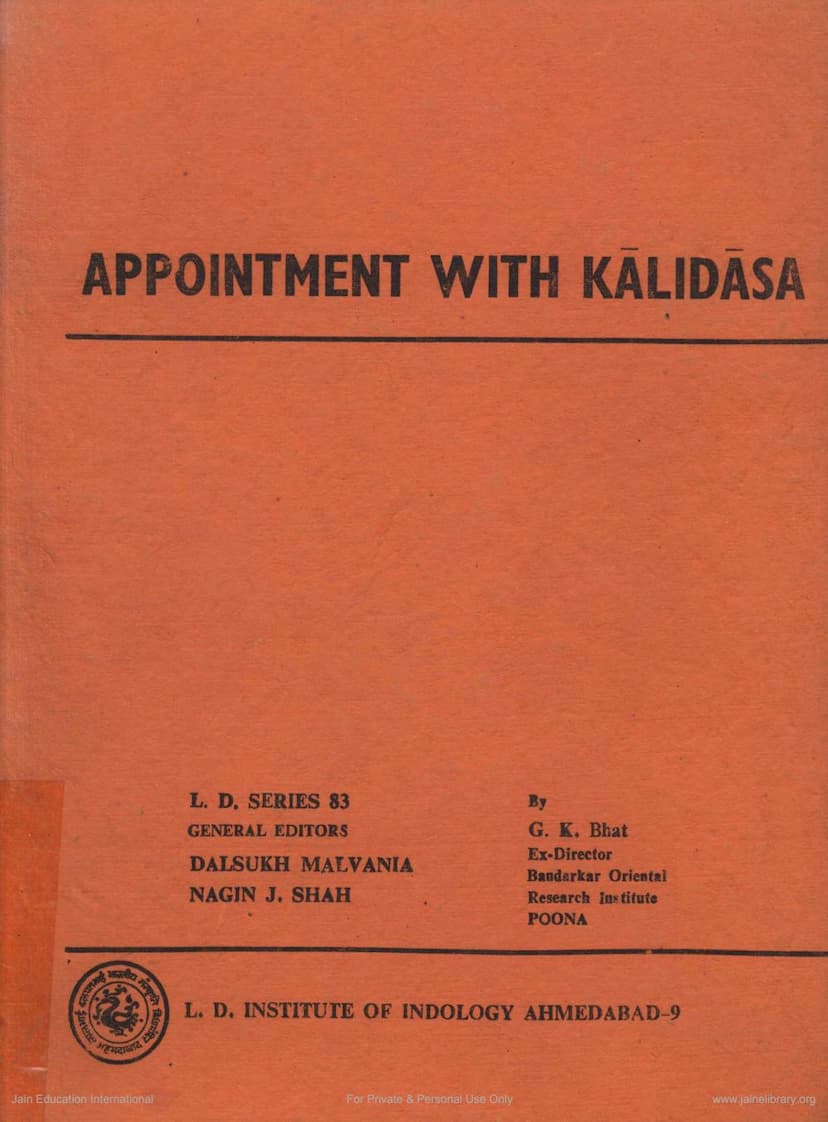Appointment With Kalidasa
Added to library: September 1, 2025

Summary
Here's a comprehensive summary of the Jain text "Appointment with Kalidasa" by G. K. Bhatt, based on the provided text and catalog link:
Book Title: Appointment with Kalidasa Author: G. K. Bhat Publisher: L. D. Institute of Indology, Ahmedabad Publication Date: First Edition, January 1982
Overview:
"Appointment with Kalidasa" by G. K. Bhat is an in-depth exploration of the life, works, thought, personality, and artistic genius of the renowned classical Sanskrit poet, Kalidasa. The book aims to provide readers with a comprehensive introduction to Kalidasa, encouraging a deeper appreciation of his profound literary contributions and his insightful perspective on life.
Key Themes and Content:
The book is structured to cover various aspects of Kalidasa's legacy:
-
Period of Life and Activity:
- The book begins by addressing the significant challenge of accurately dating Sanskrit poets, including Kalidasa.
- It discusses the two main historical periods considered for Kalidasa: the 1st century BC (linked to Vikramaditya and the Vikrama Samvat) and the 6th century AD (during the Gupta period).
- Bhat meticulously examines the evidence supporting each viewpoint, including literary allusions, inscriptions, linguistic analysis, and art history. He leans towards the earlier date (1st century BC) based on cumulative evidence, particularly from art representations that show striking parallels to Kalidasa's descriptions.
-
Literary Works:
- Bhat details Kalidasa's seven generally accepted major works:
- Two lyrical poems: Rtusamhara (Description of Seasons) and Meghaduta (The Cloud Messenger).
- Two epics: Kumarasambhava (Birth of Kumara) and Raghuvamsa (Lineage of Raghu).
- Three plays: Malavikagnimitra, Vikramorvasiya, and Abhijñānaśākuntala.
- For each work, Bhat provides a summary of its plot, themes, poetic style, and highlights specific artistic achievements, such as the emotional portrayal in Meghaduta or the depiction of nature and human emotions.
- He also addresses debates about the authenticity of some works, like the Rtusamhara, suggesting it might represent Kalidasa's early apprenticeship.
- Bhat details Kalidasa's seven generally accepted major works:
-
Glimpses of Personality:
- Bhat acknowledges the scarcity of direct biographical information about Kalidasa, noting the poets' general reticence.
- He analyzes the legends and traditional tales surrounding Kalidasa, critically examining their historical veracity while seeking underlying personal qualities.
- The book explores Kalidasa's likely personality traits derived from his literature, including:
- His profound connection with nature, viewing it as a living, responsive entity.
- His keen sense of beauty, often discovering it in unexpected details.
- His cheerful and playful outlook on life, evident in his humor and the Vidusaka characters.
- His tendency to avoid the depiction of the dreadful and bitter aspects of life, preferring tranquility and peace.
- His comprehensive education, encompassing both scholastic knowledge and mastery of fine arts.
- The analysis suggests Kalidasa had close contact with royal life, possibly serving as a poet and even an official.
-
World of Thought:
- Bhat delves into Kalidasa's reflections on religion, politics, and society, situated within the transitional period of ancient Indian history.
- He discusses Kalidasa's appreciation for the revival of Brahmanism, the emphasis on sacrificial rituals, and his personal devotion to Shiva, while maintaining a generally respectful and non-sectarian approach.
- Kalidasa's political thought is characterized as royalist, advocating for just and benevolent monarchy, with kings acting as fathers to their people and adhering to moral governance, albeit within the existing social framework.
- Socially, Kalidasa accepts the prevailing varna and ashrama dharma, emphasizing duty and adherence to tradition. He also reflects contemporary views on marriage and the position of women, while subtly advocating for mutual affection and respect within the constraints of the era.
- The book touches upon Kalidasa's views on education, highlighting the importance of comprehensive learning, the guru-shishya relationship, and the integration of fine arts.
- His concept of literature emphasizes the principles of rasa (aesthetic sentiment) and dhvani (suggestion), viewing poetry as a spontaneous expression of deeply felt emotion and a communication between the artist and the audience.
-
Supreme Theme: Srngara or Love:
- This section is dedicated to Kalidasa's primary theme: śrngara (love).
- Bhat addresses objections raised against the depiction of love in literature, particularly from conservative and spiritualistic viewpoints, arguing for the universality and artistic significance of love as a theme.
- He critically examines the "sublimation thesis," which interprets Kalidasa's love portrayals as a transcendence of the physical to the spiritual. Bhat argues that this interpretation is often an imposition of later philosophies onto Kalidasa's art, which he believes was more grounded in celebrating love and life in its various natural stages.
- He analyzes Kalidasa's heroes and heroines, highlighting their valor, loyalty, and the mutual respect and consent in their relationships, even within the context of polygamy.
- Bhat emphasizes that Kalidasa's treatment of love is not about suppressing natural impulses but about understanding and cherishing them within moral and social bounds, leading to a fulfilling life and, ultimately, spiritual progress.
- He discusses the significance of separation and reunion in Kalidasa's love stories as tests that deepen love and understanding.
- The book concludes that Kalidasa's philosophy of love promotes a balanced enjoyment of life, embracing all stages and experiences, and advocating for equality and dignity, particularly for women, within the framework of art.
Overall Significance:
"Appointment with Kalidasa" is a scholarly yet accessible work that seeks to demystify the great poet. G. K. Bhat's analysis bridges the gap between Kalidasa's classical world and the modern reader, providing a nuanced understanding of his literary art, philosophical outlook, and enduring relevance. The book is a valuable resource for scholars of Sanskrit literature and anyone interested in the rich tapestry of Indian culture and thought as expressed through one of its greatest literary figures.